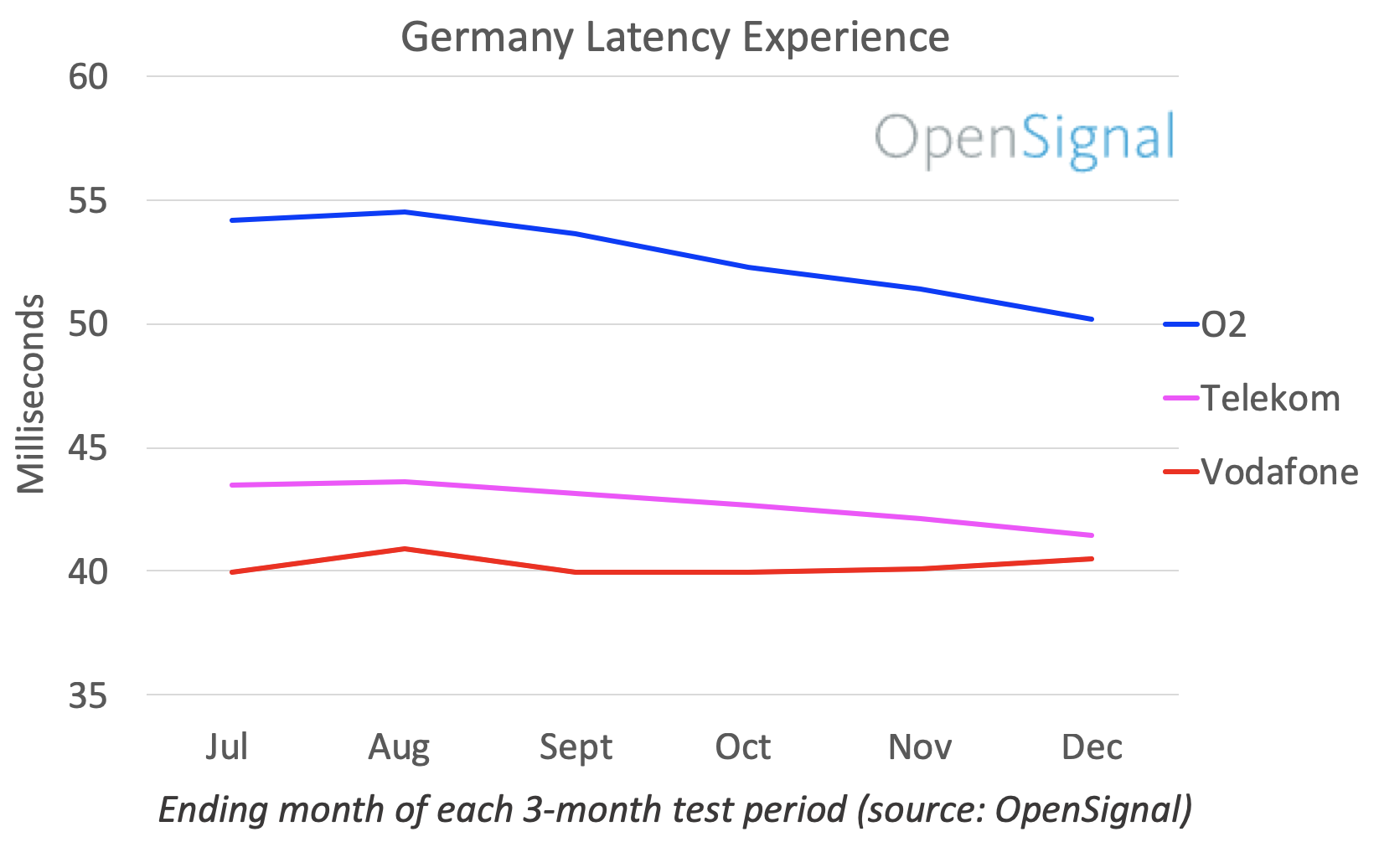According to OpenSignal's analysis of Latency Experience in Germany, there have been some notable improvements on the networks of some of the key operators over the second half of 2018. And these improvements are allowing Germany's other operators to challenge the dominance of market leader Telekom. Our Latency Experience metric is calculated as an average of the individual 3G and 4G latency measurements based on the proportion of time OpenSignal users spend connected to each network type. A lower score in this metric is a sign of a more responsive network. Read more information on our metrics and methodology.
Our measurements in Germany found that O2 has shown the greatest improvement in its Latency Experience since the middle of 2018, falling from 54ms in the 90-day sample period of May-July to 50ms in October-December — an improvement of over 7% in six months. Our analysis shows Telekom's Latency Experience improved by 2ms (or 4.6%) in the same period, while leader Vodafone stayed almost flat, with less than 1ms change in its score. In the October-December period there was less than 1ms separating Telekom and Vodafone's Latency Experience scores, according to our measurements.

Although Telekom dominates most of the OpenSignal awards in Germany, it does not win Latency Experience. In our most recent Mobile Networks Update report, Telekom won five out of seven of our awards — but both 3G and 4G latency metrics were topped by Vodafone. In our measurements of 4G Latency, Vodafone's score of 35.4ms was a 12% reduction compared its closest rival Telekom. This gap was even larger in 3G Latency, where our analysis found Vodafone's score of 50.7ms was a clear 17% ahead of its closest rival.
If we look at our 4G Latency measurements over the past 6 months however, we see the gap between operators is narrowing. This is more noticeable in 4G Latency than in our Latency Experience metric. The gap between Vodafone and Telekom is slightly wider — but still narrowing — while O2 is much closer to its nearest rival, as its score was within 6ms of Telekom in our October-December sample period.

So what is a good latency score? The lower the latency, the better. A score of below 50ms will generally be adequate for most applications we use on our mobile devices, but a latency of 30ms or less is exceptional. We've only reported sub-30ms Latency Experience scores three times in our European Mobile Networks reports — as an average score across our smartphone users on the 4G networks of T-Mobile in the Netherlands, Proximus in Belgium, and Swisscom in Switzerland. Germany has yet to join this elite group, but given the improvements in latency we are currently tracking, it won't be long before one of its operators passes the 30ms milestone.
Latency is key to the entire mobile user experience
Latency plays a role in virtually every mobile data connection, from VoIP calls to mobile video and online gaming. The better the latency, the less likely you are to experience lag on voice calls or slow loading and stalling on video. And fast latency is becoming more and more vital in gaming with the increasing popularity of multiplayer online action games relying on fast reactions like Fortnite and PUBG.
There's little doubt mobile habits in Germany are changing. A recent study found that mobile gaming revenue grew faster than the entire German gaming market in 2017, while the continued proliferation of smartphones and video platforms means mobile video is on the rise. And Germany's operators are moving to embrace this, as Telefónica-owned O2 continues its fairly aggressive 4G rollout, which goes some way to explain the improvement in Latency Experience because 4G technology offers much better latency than the older 3G networks.
The challenge for operators is to balance existing network upgrades against investment in new technologies. As Germany's forthcoming 5G auction looms large on the horizon, Telekom continues to flex its financial muscle. But with widespread consumer 5G use still likely to be some years off in Germany, the key battleground will remain on 4G networks — and improvements in latency are helping close the gap between the country's operators.
What's your experience of the effect of improved latency on mobile video and gaming in Germany? Let us know on our Twitter page.
Opensignal Limited retains ownership of this insight including all intellectual property rights, data, content, graphs & analysis. Reports and insights produced by Opensignal Limited may not be quoted, reproduced, distributed, published for any commercial purpose (including use in advertisements or other promotional content) without prior written consent. Journalists are encouraged to quote information included in Opensignal reports and insights provided they include clear source attribution. For more information, contact [email protected].
